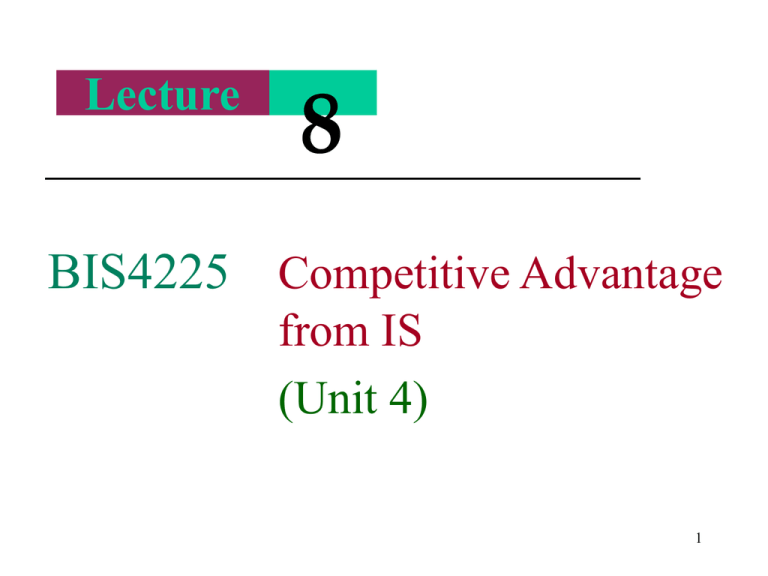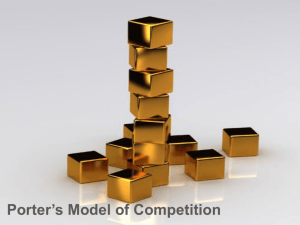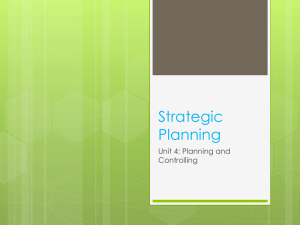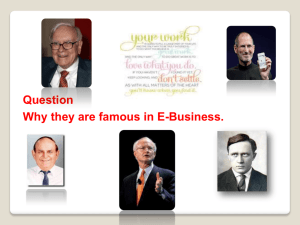Chapter Slides
advertisement

Lecture 8 BIS4225 Competitive Advantage from IS (Unit 4) 1 Unit Aims: • The nature of competitive advantage • How do we analyse an organisation’s competitive position in the industry? • Can we use IS to gain and sustain competitive advantage? 2 Relevant Texts • • • • Turban et al.: 4th Ed.Chapter 3 5th Ed. Appendix 1A, Chapter 12 Laudon and Laudon, Chapter 3 John Ward and Joe Peppard, (2002), Strategic Planning for Information Systems, 3rd Edition, John Wiley & Sons, ISBN 0470841478 Wendy Robson, (1997), Strategic Management and Information Systems, 2nd Edition, Pitman Publishing, ISBN 0273615912 3 What is competitive advantage? What is the defining factor? “An advantage over a competitor such as lower cost or quicker deliveries”. Turban et al.: G2 4 • Lack of understanding in the process of creating competitive advantage • Assumption: ‘a company knows or is aware where it is and where it wants to be’ • Pressure from the shareholders and Wall Street • Analysis of the critical resources Best resources and capabilities + right governance structure to make use of them 6 The technology onion diagram IS Hype (Feeny (1989) in Robson, 1997:257 IS Capability Useful IS SIS 7 Hypercompetition “An environment characterised by intense and rapid competitive moves, in which competitors must move quickly to build new advantages and [simultaneously] erode the advantages of their rivals” (‘Rise of Hypercompetition in the U.S. Manufacturing Sector, 1950-2002’ by L.G.Thomas and Richard D´Avani) High velocity competition 8 Strategic Competitive Advantage – Traditional View Exploitation Profits from a sustained competitive advantage Launch Counterattack Time 9 Richard D’Avani and Robert Gunther Strategic Competitive Advantage – Hypercompetition Exploitation Firm has already moved to advantage 2 Profits from a series of actions Time Launch Counterattack 10 Richard D’Avani and Robert Gunther Interrelation of influences on ISS and ITS IS Strategy IT Strategy Factors external to the organisation Competitive forces within an industry (Porter) Environmental influences on the organisation (PEST analysis) CSF Exploitation of IT through the value chain (Porter) Factors internal to the organisation Internal stages of growth (Earl) Dynamic interaction of internal forces Constraints on the exploration of IT Strategic grid showing impact of IT applications (McFarland) 11 Adapted from Curtis and Cobham, p50 Potential new entrants Threat of new entrants Suppliers Bargaining power of suppliers Industry Competitors Intensity of rivalry Buyers Bargaining power of buyers Threat of substitutes Substitutes 12 http://www.strategy4u.com/asses sment_tools/porters_five_forces/f ive_forces_popup.shtml 13 What factors will affect new entrants? Capital requirements Patents and specialists skills required Distribution channels available Differentiation of brand/establishment Access to raw material/ critical resources Number and size of existing rivals and intensity of competition What is a substitute in Porter’s model? “products or services within the industry but are differentiated in some way” (Curtis and Cobham, 2005:52) direct substitutes indirect substitutes aluminium beverage cans substitutes are: glass bottles, steel cans, plastic containers new tires Vs retreads different types of TV transmissions What factors do you think will affect threat of substitutes? The relative price and performance of substitutes Switching cost for customers Buyer’s inclination to substitute Bargaining power of suppliers • Supplier Concentration • Differentiation of inputs • Importance of volume to supplier • Switching costs of suppliers and firms in the industry 17 POTENTIAL NEW ENTRANTS Foreign General merchandisers or Discounters Established retailers shifting strategy to discounting or mega stores Internet vendors SUPPLIERS INDUSTRY RIVALRY Kmart, Target, Toys R Us, Speciality stores, Small Retailers BUYERS SUBSTITUTES Mail order catalogue, Home shopping (TV) Internet 18 shopping, telemarketing, door-to-door sales Knowledge of these underlying sources of competitive pressure: • Highlights the critical strengths and weaknesses of the company • Animates its position in its industry • Clarifies the areas where strategic changes may yield the greatest payoff 19 • Highlights the areas where industry trends promise to hold the greatest significance as either opportunities or threats. • Useful in considering areas for diversification. 20 Assessing the competitive position of the organisation The model can be used: • To assess the most significant of the five forces • To question what IS opportunities relate to those significant forces 21 Does IS change the basis of competition within a market? Can IS change the balance of power with suppliers? Does new IS increase or decrease bargaining power? Can organisations switch suppliers more or less readily? Can IS build barriers to entry? Does IS increase or decrease the barriers to entry to a market sector? Can IS change the basis of competition? Can IS build in switching costs? Can IS generate new products or services? Does new IS increase or decrease bargaining power? Are customers switching costs or barriers changed? 22 Robson, page 128 Excellent description of the Porter’s Model and associated concepts www.quickmba.com/strategy/porter.shtml See how Porter’s Model is used in industry at www.brs-inc.com/porter.html 23 Environmental Influences • The economy – free market – strengths of different currencies • Society – retired people and their relative influence • Political – European Union – dismantling of trade barriers – removal of restriction legislation – elimination of tariff 24 Important environmental factors: • Legal – Data protection act – Business and labour laws • Ecology – “Green” movement • Technology • Employees and Unions 25 The Impact of Internet on Porter’s See Figure 12.1 on page 510 of Turban et al., which illustrates some ways the use of the Internet can alter the industry structure. 21:03 26 •‘Strategy and the Internet’, Michael E. Porter, Havard Business Review, Volume 79, Number 3, March 2001 •A good article to read, critical analysis of the above: ‘Fathoming Porter's five forces model in the internet era’, G.D. Karagiannopoulos, N. Georgopoulos, K. Nikolopoulos, Emerald, Volume 7 Number 6 2005 pp. 66-76 27 SWOT/TOWS Analysis • • • • Strengths Weaknesses Opportunities Threats INTERNAL EXTERNAL http://www.NetMBA.com/strategy/ 21:03 28 21:03 Opportunity Threat Situation IS faces Possible Responses on basis of SWOT Analysis Attack ‘go for it’ Beware ‘don’t do it’ Explore ‘if have time’ Project ‘watch yourself’ Strengths Weaknesses Evaluation of IS Capability 29 Robson, 2nd Edition, page 115 External Macro Environment • SLEPT Political Social Economic Legal • PESTEL Socio-cultural Economic Technological Political Environmental Legal Technological 21:03 30 Economy at Large Substitutes Micro Environment Suppliers Substitutes Buyers Suppliers Company Company Rival firms 21:03 Thompson and Strickland, 2003:74 New Entrants Buyers New Entrants 31 The three generic business strategies • Overall cost leadership • Overall differentiation • Focus/ Niche 32 Generic Competitive Strategies Differentiation Overall cost leadership Differentiation (value added) Cost Based Focus (Niche) Differentiation Based Focus Competitive Scope Low Cost Broad industry-wide Narrow selected market 33 Other Response Strategies • • • • • Growth Alliances Innovation Improved internal efficiency Customer-oriented approaches and CRM Table 1A.1, page 45: 12 general strategies See Chapter 12 of Turban et al. 34 Value Chain “every firm is a collection of activities that are performed to design, produce, market, deliver and support its product. All these activities can be represented using value chain.” Michael Porter (1984), Competitive Advantage, Free Press 35 Value Chain • Help understand the internal nature of the organisation • Represents the organisation as a connected chain of activities • Each activity adds value 36 37 http://www-mmd.eng.cam.ac.uk/people/ahr/dstools/paradigm/valuch.htm Primary Activities • Contributes to getting the output close to the customer • Have a direct relationship with the customer Secondary Activities • Supports or facilitates the smooth functioning of the primary activities • Only have an indirect relationship with the value adding process 38 Support activities Administration and Infrastructure Human Resource Management Product and Technology Development General management of the enterprise e.g. as a business entity Recruiting, training, developing, and rewarding personnel e.g. Developing the technology of the product and processes and business management e.g. Acquiring the required inputs to the value Value added - cost adding process e.g. Procurement Inbound logistics Receiving, storing and disseminating inputs to the product or service Operations Outbound logistics Transforming inputs to outputs Sales and marketing Providing ways in which the Distributing customer can the output purchase the to product and customers inducing them to do so Services = margin Enhancing or maintaining the value of the output once purchased 39 Primary activities Ward & Griffiths, page 217 Admin. And Infrastructure • • • • • Financial management, Planning, Legal services, Quality management, Office administration, etc. 40 Human Resource Management • • • • • Recruiting, Training, Appraising, Developing Promoting, etc. 41 Product/Technology Development • R & D, • Development of technology in support of all the organisation’s tasks • Information Systems for: HRM, accounting, internal or external telecommunication • Development of new product and service design 42 Procurement • Activities that support the procurement of inputs for all activities of the value chain • • • • • Raw material Production equipment office and factory provision office supplies Information Systems 43 A manufacturing company’s value chain Support activities General management of the enterprise as a business entity, Planning, finance, accounting, legal services, quality management Administration and Infrastructure Human Resource Management Product and Technology Development procurement Inbound logistics Personnel, Pay, Recruitment, Training, Manpower planning, etc. Product and process design, R & D, Production engineering, etc. Supplier management, funding, subcontracting, specification Operations Outbound logistics Manufacturing packaging, production Quality control, control, quality receiving, raw material control, control, etc maintenance, etc. Primary activities Finished goods, order handling, dispatch, delivery, invoicing, etc. Sales and marketing Customer Mgt, order taking, promotion, sales analysis, market research, etc. Value added - cost = margin Services Warranty, Maintenance education/ training upgrade, etc 44 Ward & Griffiths, page 218 A Airline industry value chain Administration and Infrastructure Financial Policy Accounting Regulatory companies Flight, Route Pilot training Baggage and Yield handling Safety Analyst training training training Computer Reservation System, Inflight system, Flight Scheduling system, Yield management system E-procurement, Warehousing, Inventory Management •Route selection •Passenger services •Pricing •Flight scheduling •Crew scheduling •Facilities plan •Ticket counter operations •Baggage system Legal Community Affairs Agent training Product development Market research Material handling •Promotion •Advertising •Gate operations •Flight •Frequent flyer Connections • Aircraft •Travel agent operations •Rental car programs •Onboard Service and hotel •Group sales •Baggage handling reservation system •Electronic •Ticket Offices Inflight training Baggage tracking system Maintenance Profit margin •Lost baggage service •Complaint follow up tickets 45 (Turban et al. 4th Edition, 2004:109) The Value System Supplier’s Value Chain Company’s Value Chain Distributor’s Value Chain Buyer’s Value Chain 46 Ward &Peppard, page 249 Informing the market to create demand Operational information exchange to enable matching of supply and demand SUPPLY CONVERSION PRODUCT & SERVICE LOGISTICS Gathering information to understand the demand CONSUMPTION 47 By better information change through the value chain we can: • Create more demand • Satisfy more of the available demand (gain market share) • Reduce the cost of satisfying the demand 48 Value chain leads to: • CRM – Customer Relationship Management • Strategic Alliance • SCM – Supply Chain Management 49 Weaknesses of the traditional value chain • Most applicable to manufacturing products as opposed to services • A one-way chain pushing products to customers • Does not emphasise the importance of value networks 50 Value chain of a lodging outfit Guests stay Marketing & Sales Procurement After-stay service Production 51 (Piccoli, 2008) The Customer Service Life Cycle (CSLC) Where do I get it? How much? Delivered When? What is it? Do I need One? Which One? How many? How much am I spending? How do I use it? Is there a new one? How do I fix it? How do I return it? (Ives and Willinger, 1999 at: www.uhisrc.com/pdf/abs9.pdf) 52 Life Cycle Phase Stages in each phase REQUIREMNTS Establish requirements Establish a need fort he product or service Specify Determine the product or service attributes ACUISITION Select source Determine where to obtain the product or service Order Authorize and pay Acquire Evaluate and accept OWNERSHIP Integrate Monitor Upgrade Maintain RETIREMENT Transfer or dispose Account for 53 low high (Contribution of IS/IT to the business now) Strategic impact of existing operation systems Strategic impact of application development portfolio (or planned IS) (Contribution of IS/IT to the business in the future) high low Support Turnaround (high potential) Large chemical company Insurance broker Medium sized grocery chain Large process industry manufacturer Factory (key operational) Strategic Major bank 1980 Major airline $100 M distributor Large insurance company Major bank 1981 54 The Support Quadrant Applications that are valuable but not critical to success • provides a support activity • not characterised by their high investment in IT • IT is not a part of the overall strategic business plan • management’s perception of IT fits that of the DP or EDP era 55 The Factory (key Operational) Quadrant Applications on which the organisation currently depends for success • IT is crucial to existing operations but is not critical to company’s overall strategic direction • IT budgets are usually significant, yet the key goals are reliability and efficiency • IT budget must not exceed agreed financial limits 56 The Strategic quadrant Applications that are critical to sustaining future business strategy • Important in assessing the degree to which companies deploy IT for competitive advantage • Organisations will not function without IT, i.e. IT is an integral part of the business • IT is a major part of the corporate infrastructure 57 • IT budget is likely to be huge The Turnaround quadrant Applications that may be important in achieving future success • companies recognise the growing importance of IT as a means to improve competitive position • IT budgets are jumping up step-curves • leadership is coming from the board • a top IT executive is being appointed • education programmes in information management are being commissioned for senior executives. 58 Improve business efficiency and management Innovative applicationsPortfolio which may create Application Sustain the existing effectiveness but, in themselves, do notWard sustain and Peppard, page 42) opportunities to gain a create future or advantage, but are support change business operations, the business or provide any Turnaround competitive(high Support as yet unproven. in how the organisation helping to avoid any advantage potential) conducts its business, disadvantage. E.g. EPOS, Applications that are Applications that may with the aim of providing ATM, ERP. but Most valuable not of them be important in advantage. to success achieving future havecritical become mandatory competitive success for survival in the industry. Factory (key operational) Applications on which the organisation currently depends for success Strategic Applications that are critical to sustaining future business strategy 59 Application Portfolio Ward and Peppard, page 42) Support Improve business efficiency and management effectiveness but, in themselves, do not sustain the business or provide any competitive advantage Factory (key operational) Sustain the existing business operations, helping to avoid any disadvantage. E.g. EPOS, ATM, ERP. Most of them have become mandatory for survival in the industry. Turnaround (high potential) Innovative applications which may create opportunities to gain a future advantage, but are as yet unproven. Strategic create or support change in how the organisation conducts its business, with the aim of providing competitive advantage. 60 SWOT/TOWS Analysis • • • • Strengths Weaknesses Opportunities Threats http://www.NetMBA.com/strategy/ 61 Opportunity Threat Situation IS faces Possible Responses on basis of SWOT Analysis Attack ‘go for it’ Beware ‘don’t do it’ Explore ‘if have time’ Project ‘watch yourself’ Strengths Weaknesses Evaluation of IS Capability 62 Robson, 2nd Edition, page 115





